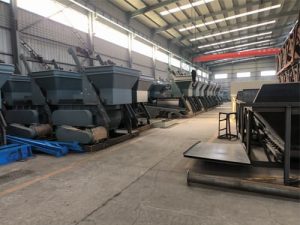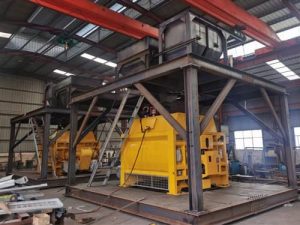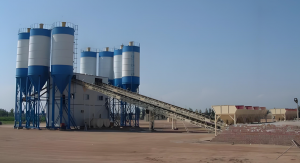Relative News
Products
At a time when infrastructure construction is developing rapidly, concrete batching plant, as a key node in the construction industry chain, have a working efficiency that is directly related to the advancement speed and cost control of engineering projects.
Data show that for every 10% increase in the efficiency of mixing stations, the energy consumption per unit of production capacity can be reduced by 8%-12%, and the comprehensive operating costs can be reduced by more than 15%. However, the current industry generally faces problems such as waste of raw materials, idling of equipment, and process blockage, and the effective operating time of some mixing stations accounts for less than 60%.
This article will start from the entire production process, combine modern engineering management concepts and intelligent technology applications, and systematically explain the practical path for improving the efficiency of mixing stations, and provide the industry with an optimization solution that combines technical depth and economy.
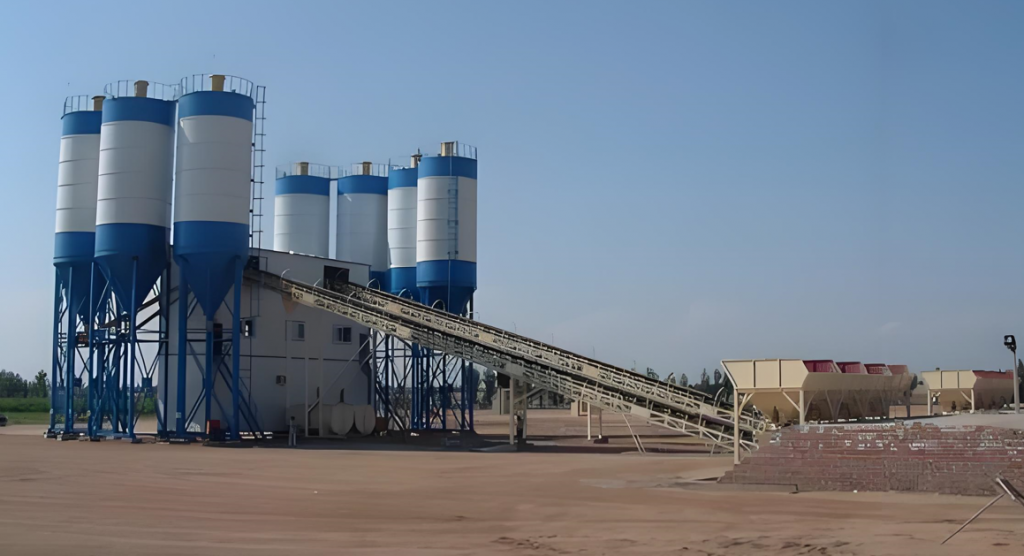
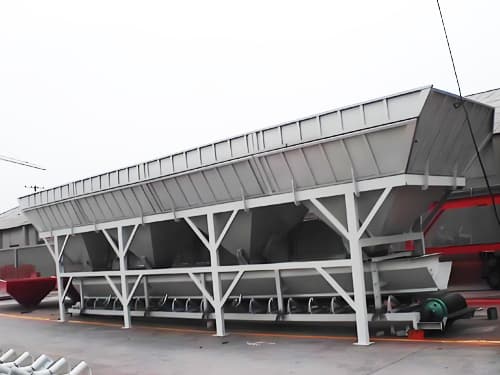

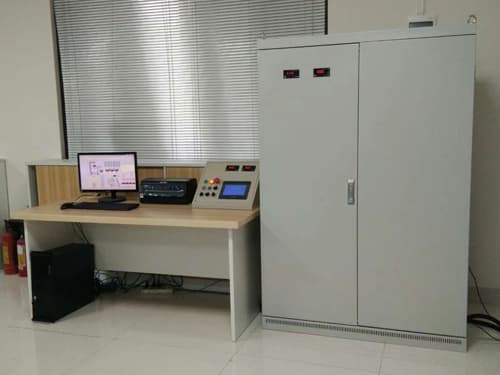
I. Optimize the feeding process of concrete batching plant:
Build an efficient and accurate raw material supply system
The first process of concrete production-the feeding link, is like the “throat” of the concrete batching plant and its smoothness directly determines the rhythm of subsequent links. Statistics from a large-scale infrastructure project show that production interruptions caused by delays in the feeding link account for as high as 42%, so building a scientific feeding system is the primary breakthrough for improving efficiency.
1.1. Improve the speed of raw material delivery
The optimization of raw material delivery speed requires coordinated efforts from three aspects: mechanical design, material characteristics, and operating specifications. In the sand and gravel aggregate delivery system, the amplitude and frequency settings of the vibrating feeder are particularly critical.
Taking a certain HZS180 concrete batching plant as an example, when the feeder frequency is adjusted from 45Hz to 55Hz, the time for a single batch of sand and gravel is shortened from 60 seconds to 45 seconds, but excessive speed increase may cause material segregation. Therefore, it is necessary to establish a “speed-uniformity” balance model and realize the dynamic feeding parameter adjustment of aggregates of different particle sizes through the PLC control system.
The blockage problem of the powder delivery system has long plagued the industry. Its essence is the “arch bridge effect” caused by the mismatch between powder fluidity and equipment geometric parameters. A project case shows that the traditional vertical feed pipe is transformed into a 60° inclination angle and a pneumatic percussion hammer (working pressure 0.6MPa, percussion frequency 30 times/minute) is installed, which can reduce the incidence of cement blockage from 3 times a week to 1 time a month.
A more advanced solution is to use fluidizing rod technology, which fluidizes the powder by introducing dry compressed air (dew point ≤ -40℃) into the bottom of the powder silo, increasing fluidity by more than 40%.
The corrosion problem of powder hoppers is particularly prominent in rainy areas. Monitoring data from a coastal concrete batching plant showed that the average service life of powder hoppers made of ordinary carbon steel was only 8 months, while the service life was extended to more than 5 years after using 316L stainless steel plates and applying polyurea anti-corrosion coating (dry film thickness ≥ 200μm).
It is recommended to establish a powder hopper corrosion monitoring mechanism, use an ultrasonic thickness gauge to detect the wall thickness every month, and repair it immediately when the local corrosion depth reaches 30% of the original thickness.
1.2. Raw material management and storage
The scientific nature of aggregate storage directly affects the continuity of subsequent production and the stability of concrete quality. In terms of stacking layout, the principle of “zoning and classification, first-in-first-out” should be followed, and coarse aggregate (5-31.5mm) and fine aggregate (0-5mm) should be divided into at least 3 independent silos, each with a capacity of not less than 200m³, and a partition wall with a height of not less than 1.8m should be set to prevent mixing.
A green concrete batching plant innovatively adopts the “three-dimensional silo” design, which uses steel structure brackets to raise the silo to 3 floors, increasing the land utilization rate by 200%. At the same time, it is equipped with a fully automatic spray dust reduction system (fog particle diameter 5-10μm, coverage rate 100%), and the dust emission concentration is controlled below 10mg/m³.
The scientific configuration of storage volume needs to be combined with the supply chain cycle and production fluctuations. By establishing a “safety stock model”: aggregate safety stock = average daily consumption × (purchase cycle + weather impact coefficient) × 1.5 times redundancy coefficient.
Taking South China as an example, considering the three-day transportation interruption that may be caused by the typhoon season, when 800 tons of aggregate are consumed on a certain day, the safety inventory should not be less than 800×(5+3)×1.5=9600 tons. For powder storage, attention should be paid to moisture-proof issues. Silos should be equipped with temperature and humidity sensors (monitoring accuracy ±2℃, ±5%RH). When the humidity in the silo exceeds 75%, the heating and dehumidification device will be automatically activated to ensure that the stability of the cement is qualified.
II. Improve mixing efficiency:
Achieve a balance between homogenization and high speed
The mixing process is the core process that determines the homogenization of concrete. To improve its efficiency, it is necessary to shorten the mixing cycle through equipment optimization and process innovation while ensuring the strength index.
Test data show that for every 1 level increase in concrete mixing uniformity, the amount of cement can be reduced by 5%-8%, and the 28-day compressive strength can be increased by 3-5MPa.
2.1. Regularly check the internal structure of the mixer
The blades and linings of the mixing main unit are like “teeth”, and their wear condition directly affects the mixing effect. The use of non-destructive testing technology (such as magnetic particle inspection) can detect blade cracks in advance and avoid sudden failures.
A certain engineering practice shows that replacing the traditional high manganese steel blade (ZGMn13) with a bimetallic composite blade (tungsten carbide + low-carbon steel matrix) can extend the service life from 3,000 cans to 8,000 cans, and reduce the mixing resistance by 15%. Establish a “wear warning system” to monitor the load changes of the mixing shaft in real time by installing a torque sensor. When the torque value exceeds 120% of the rated value, an automatic alarm will be issued to prompt the replacement of the blade.
Standardized procedures should be formulated for cleaning and maintenance work. After each production, a high-pressure water gun (working pressure 15MPa) is required to flush the inner wall of the mixing tank, focusing on cleaning the residual concrete at the root of the blade.
Deep cleaning is performed once a week, and the discharge door is disassembled to check the wear of the sealing strip to ensure that the gap does not exceed 2mm. An intelligent concrete batching plant introduced an automatic cleaning robot. Through the combination of a 360° rotating nozzle and a mechanical scraper, the cleaning time was shortened from 45 minutes manually to 15 minutes, saving 30% of water.
2.2. Prevent the “shaft sticking” phenomenon
“Shaft sticking” is essentially the accumulation of adhesion of concrete mixture on the surface of the mixing shaft, which is usually caused by improper mix design, feeding sequence, and mixing parameters. This problem can be effectively alleviated by adjusting the admixture dosage: when the polycarboxylate water reducer dosage is increased by 0.2%, the cohesiveness of the concrete is reduced, and the amount of shaft sticking is reduced by about 40%. Feeding sequence optimization is also critical. The “stone-cement-sand-water” feeding sequence can make cement form cement slurry in advance to wrap the surface of the sand and gravel, reducing direct adhesion to the shaft.
A concrete batching plant innovatively applied “ultrasonic anti-sticking technology” and implanted an ultrasonic vibrator (frequency 20kHz, power 500W) on the surface of the mixing shaft. The high-frequency vibration destroyed the adhesion conditions of the concrete, and the shaft sticking cleaning cycle was extended from once per shift to once every three shifts.
At the same time, an online monitoring system for the amount of shaft sticking was developed. The thickness of the adhesion layer was measured in real time through displacement sensors installed at different heights of the shaft body. When the thickness exceeds 50mm, the cleaning program was automatically started.
III. Optimize the discharge link:
Build a connection mechanism for rapid transportation
Discharging efficiency is the “last mile” that restricts the overall production capacity of the concrete batching plant. Its optimization requires the seamless connection between equipment and vehicles. A concrete batching plant reduced the unloading time of a single vehicle from 6 minutes to 4 minutes through the transformation of the discharging system, and the average daily concrete transportation volume increased by 300m³.
3.1. Matching of discharge port design and transport vehicle
The matching degree between the discharge port and the transport vehicle determines the upper limit of the unloading speed. The diameter of the feed port of a conventional transport tanker is 500mm, so the discharge port diameter should be designed to be 350-400mm, and an eccentric arc gate (opening angle ≥120°) should be used to ensure uniform material flow without impact. In one case, the traditional circular discharge port was changed to a square gradient structure (upper width 400mm×400mm, lower port 350mm×350mm), and the discharge time was shortened by 25% with the pneumatic double-cylinder drive gate.
The innovative design of the discharge hopper can greatly improve the turnover efficiency. With the “double-bin discharge hopper” (total capacity 8m³), when one tanker is unloading, the other bin can simultaneously complete the temporary storage of concrete, realizing the continuous operation of “one tank after another”.
In cold areas, the discharge hopper needs to be equipped with an electric heating system (power 2kW/m²) to ensure that the temperature of the concrete out of the machine in winter is not lower than 10℃, avoiding the loss of fluidity due to low temperature.
3.2. Transport vehicle configuration
The scientific configuration of the transport fleet requires the construction of a dynamic balance model of “production-transportation-casting”. Based on the queuing theory, when the hourly capacity of a concrete batching plant is 180m³, the transportation time of a single vehicle (including round trip, loading and unloading) is 60 minutes, then the number of vehicles required = (180×60)/(60×8) = 22.5 vehicles. Considering the 10% standby factor, the actual configuration is 25 vehicles. A smart concrete batching plant introduced a GPS scheduling system to display the location and status of each vehicle in real time, and optimized the transportation route through the Dijkstra algorithm, so that the average daily effective transportation trips of a single vehicle increased from 8 times to 10 times.
The vehicle maintenance system is also critical. Establish a “three-inspection system”: check the tire pressure (standard 0.8MPa) and the sealing of the discharge chute before leaving the vehicle; monitor the speed of the tanker through the remote monitoring system during transportation (guarantee 2-4r/min); rinse the tank immediately after returning to the concrete batching plant site (focus on cleaning the residual concrete at the feed port). Data from a concrete batching plant shows that standardized maintenance can reduce the vehicle failure downtime rate from 8% to 2%, reducing maintenance costs by 150,000 yuan per year.
IV. Strengthen equipment maintenance and management:
Build a full life cycle guarantee system
The equipment integrity rate is the basic guarantee for the efficient operation of the concrete batching plant. Industry statistics show that the overall equipment efficiency (OEE) of a concrete batching plant with a preventive maintenance system can reach more than 85%, while it is only about 60% in the passive maintenance mode.
4.1. Regularly check the electrical system
The electrical system is like the “nervous system” of the concrete batching plant, and its stability determines the continuity of production. Establish a three-level inspection system: daily inspection (every 2 hours) to check the status of the control cabinet indicator light and whether the cable is overheated; weekly inspection uses an infrared thermal imager (temperature measurement accuracy ±1℃) to detect the temperature of key nodes, and the contactor temperature rise shall not exceed 60K; monthly inspection conducts insulation resistance test (phase-to-phase insulation ≥1MΩ). A concrete batching plant introduced an intelligent electrical management system, which collects current, voltage, and temperature parameters in real time through the Internet of Things module to achieve early warning of faults, and reduce the downtime of electrical faults by 70%.
The reliability of the butterfly valve directly affects the powder metering accuracy. The response time of the pneumatic butterfly valve needs to be checked every week (should be ≤0.5 seconds), and the valve opening should be calibrated every month (the error should not exceed ±1°). Adopting the “double valve redundancy design”, two sets of butterfly valves are set up in the important metering circuit. When the main valve fails, it automatically switches to the backup valve. The switching time is less than 2 seconds to ensure uninterrupted production. In one case, this design reduced the downtime rate caused by powder metering failure from 5% to 0.5%.
4.2. Establish a strict maintenance system
The standardization of the maintenance system is the guarantee for the long-term operation of the equipment. Prepare the “Equipment Maintenance Manual”, break down the maintenance content into 238 specific tasks, and clarify the responsible persons and cycles. For example: the agitator shaft bearing is supplemented with lithium-based grease (NLGI grade 2) every 500 hours of operation, and the clearance is checked every 2000 hours (should be ≤0.15mm); the wear-resistant lining of the screw conveyor is replaced every 1000 hours, and the thickness wear shall not exceed 30% of the original thickness.
Introduce a digital maintenance management system (CMMS) for concrete batching plant, identify each device with a QR code, and maintenance personnel can scan the code to view historical maintenance records and spare parts information. The system of concrete batching plant automatically generates preventive maintenance work orders and issues warnings to management personnel when they are overdue and not completed. After a group concrete batching plant applied this system, the spare parts inventory turnover rate increased by 40% and the maintenance cost decreased by 25%.
V. Optimizing production organization and scheduling:
Building a lean operation model
The scientific nature of production organization directly determines the efficiency of resource allocation. Through value stream analysis, it was found that traditional mixing stations have 30%-40% non-value-added operation time, and the effective operation rate can be greatly improved through process reengineering.
5.1. Shorten preparation time
The leanness of the preparation stage can significantly improve the utilization rate of equipment. Establish a “parallel operation” mechanism: when the mixer is mixing the current batch, the weighing and transportation of the next batch of raw materials are completed simultaneously. A concrete batching plant optimizes the PLC program to overlap the sand and gravel weighing time with the cement mixing time, so that the single cycle preparation time is compressed from 45 seconds to 20 seconds. Using the “pre-weighing” technology, 5-8 batches of aggregates are reserved in advance for the mix ratio with stable dosage, and they are quickly transported to the waiting area through a belt conveyor, so that “zero waiting” production can be achieved in an emergency.
The balance of production rhythm requires the establishment of a mathematical model. Through the formula T preparation ≤ T mixing + T discharge (T is time), ensure that each link is seamlessly connected. When the mixing time is 120 seconds and the discharge time is 60 seconds, the preparation time must be controlled within 180 seconds. A certain HZS240 concrete batching plant is equipped with 4 sets of independent weighing systems to achieve parallel measurement of multiple materials, and the preparation time is stably controlled at 150 seconds, reaching the industry-leading level.
5.2. Formulate a scientific production plan
The optimization of the production plan needs to take into account both market demand and equipment capacity. The ERP system of concrete batching plant is used to integrate order information, and the APS (Advanced Planning and Scheduling) module is used to automatically generate the optimal production sequence.
For example: the same strength grade of concrete orders are concentrated to reduce the number of mix ratio switching (each switching takes about 15 minutes); the production sequence is arranged according to the distance of transportation to avoid long queues of vehicles. After a concrete batching plant applied this system, the on-time delivery rate of orders increased from 85% to 98%.
Establish an “emergency plan library” to deal with emergencies. In response to the shortage of raw materials, we signed emergency supply agreements with more than 3 suppliers (committed to deliver within 2 hours); in response to equipment failures, we reserved key spare parts (such as mixing blades and reducer gears); in response to extreme weather, we adjusted the production plan 24 hours in advance. Before the typhoon came, a concrete batching plant produced and reserved 2,000 m³ of concrete in advance to ensure the continuous construction of key projects.
VI. Technology Upgrade and Automated Control:
Enabling Intelligent Production Transformation
Automation and intelligence are the inevitable trend of improving the efficiency of concrete batching plant. Data show that after the intelligent transformation of concrete batching plant, the per capita production capacity has increased by more than 50%, and the raw material loss has decreased by 10%-15%.
6.1. Introducing an automated control system
The automated control system realizes precise control of the entire production process. Industrial-grade PLC (such as Siemens S7-1500) is used as the control core, and high-precision sensors are configured: aggregate weighing accuracy ±0.5%, cement ±0.3%, and admixture ±0.2%. Human-computer interaction is realized through the SCADA system, and production data (such as the proportion of each plate of concrete, mixing time, and outlet temperature) are displayed in real time, and abnormal conditions are automatically alarmed. A certain intelligent concrete batching plant reduces the standard deviation of concrete strength from 3.5MPa to 2.0MPa through an automatic control system, reaching the excellent level of national standards.
The equipment status monitoring system realizes predictive maintenance. Vibration sensors (measuring range 0-20mm/s) and temperature sensors are installed on key equipment (such as mixing main machine and reducer), and data is analyzed in real time through the edge computing gateway. When the vibration value exceeds 8mm/s or the temperature rises abnormally by 5℃, the system automatically issues an early warning. In one case, this technology was used to detect the bearing failure of the reducer in advance, avoiding the possible 3-day downtime loss.
6.2. Upgrade key equipment
The technical transformation of old equipment can quickly increase production capacity. Upgrading the traditional JS series mixer to the Minrui series planetary mixer shortens the mixing time by 30%, and at the same time improves the homogeneity of concrete by 2 levels. In terms of metering system transformation, the belt scale is upgraded to a modular weighing sensor (accuracy 0.01%FS), and the metering speed is increased by 40% with the dynamic compensation algorithm. Through equipment upgrades, a concrete batching plant has increased its production capacity from 120m³/h to 180m³/h without increasing the floor space.
The application of energy-saving equipment reduces costs and increases efficiency. Using permanent magnet synchronous motors to replace traditional asynchronous motors, the power saving rate reaches 20%-30%; installing frequency converters to achieve soft start of equipment to avoid starting current shock (can reduce starting current by more than 50%); using solar photovoltaic systems to meet 15%-20% of the electricity demand of the mixing station. A green mixing station saves 1.2 million yuan in electricity bills annually through comprehensive energy-saving transformation.
VII. Personnel training and operating specifications:
Building a professional and efficient operation team
The human factor is the core variable for improving efficiency. According to the survey, operators who have undergone systematic training can reduce the concrete batching plant failure rate by 40% and increase production efficiency by 25%.
7.1. Improve the skills of operators
The hierarchical and classified training system builds a professional talent team. New employees need to complete 300 hours of training, covering equipment principles (such as mixer structure, electrical control system), process knowledge (mix ratio design, concrete performance), and safety specifications (first aid for electric shock, mechanical injury protection); skilled workers conduct skills improvement training every quarter, focusing on learning new technology applications (such as automation system operation, fault diagnosis); managers participate in industry summits every year to grasp cutting-edge trends (such as green production, intelligent scheduling). A concrete batching plant has established a “master-apprentice” system, which shortens the time for new employees to take up their posts independently from 3 months to 1 month.
Emergency drills improve practical capabilities. Organize equipment failure drills every month (such as power failure handling and powder blockage elimination), and conduct safety accident drills every quarter (such as fire fighting and personnel evacuation). Through the VR simulation system, operators can immersively experience various emergency scenarios and improve the speed of emergency response. Data shows that regular drills can shorten the fault handling time by 50% and reduce losses caused by improper handling.
7.2. Standardize the operation process
Standardized operation instructions ensure operation consistency. Prepare a “Job Operation Manual” and decompose each process into “action units”: for example, the powder silo unloading operation is divided into 5 steps: “check the material level → start the screw conveyor → open the butterfly valve → monitor the flow → close the butterfly valve → stop the conveyor”, and each step clearly defines the key points and judgment criteria of the operation. Use “pictures + videos” to produce guidance materials, which are convenient for operators to quickly master.
The performance appraisal mechanism stimulates employee enthusiasm. Establish a KPI appraisal system, with indicators including production efficiency (per capita production capacity), quality qualification rate (strength compliance rate), equipment integrity rate, energy saving and consumption reduction (electricity consumption per ton of concrete), etc. Performance rewards are given to teams that achieve their goals, and those who violate regulations and cause losses are held accountable. Through performance appraisal, a mixing station reduced the production cost of a ton of concrete by 8 yuan, increasing annual efficiency by nearly 2 million yuan.
